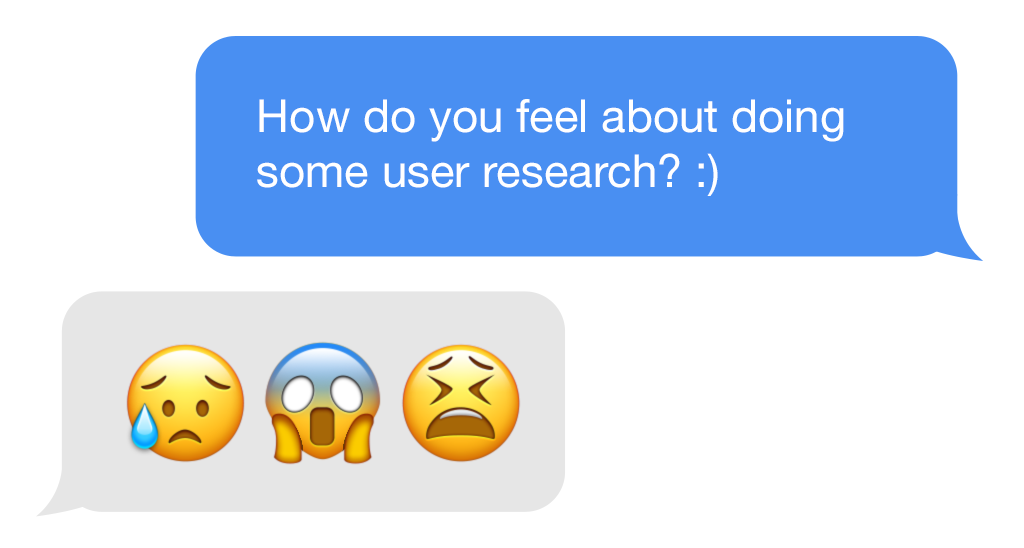I’ve met too many people and organisations that are scared of user research or testing.
Scared to the point that they won’t do it. It’s so often misunderstood, or seen as difficult or too expensive. This paralysis means that all of these organisations are forging ahead, building digital products, services, websites and apps without any sense of whether it’s suitable for their audience. You think research is expensive? Imagine how much time and money is being wasted by developing a website that isn’t fit for purpose! And in the not for profit sector, where budgets are already tight, you need to be squeezing the most out of what you’ve got.
Imagine user research wasn’t as expensive or complex as you thought, that actually you could take some small steps to doing this yourself. Suddenly, you have the missing information. You can refine your website or product, and bingo – you build something that meets your audience’s needs, and your organisation’s’ bottom line benefits. It’s possible, I promise!
What is it?!
There’s a whole heap of different exercises we can do under the term “user research” but for now, let’s focus on the problem at hand. You’ve got anecdotal evidence that your website isn’t working very well. You need to find out if your website is helpful to the people who use it, and if not, what you can do to improve it and help them achieve their goals as efficiently as possible.
User research is just an exercise to help you find this out. The specific activity I’d advocate here is user testing – “user” being, your audience, the people who use your website.
If it helps you, remove the term “user testing” and rename it “talking to your customer about their needs and your website”. That sounds a lot easier to approach, doesn’t it?
Why should I do it?
The ultimate benefit of user testing is increasing the effectiveness of your website or app. User testing allows you to align yourself with how your users’ think and what they need, and by doing this you’ll get more people to do what you want on your site – whether that’s donating, signing up, becoming a member or engaging with content.
Alzheimers Research UK did user testing to inform the redevelopment of their donation process (full article here). By using the results to influence the design of their donation form, their online donations increased by 140%!
Here’s what some of our clients say about user testing:
“User testing was not something we had done before so it was a big leap of faith. By finding out what our customers needed and building the website around them, it’s led to a 147% increase in revenue!”
“This is amazing but so frustrating to see. I was shouting at the screen: “Noooo, click there!” Haven’t finished watching it yet but the 10 minutes I have seen have opened my eyes. Fantastic stuff and gives us plenty of information to target improvements. We need more users testing.”
It’s expensive.
It can be, but it doesn’t have to be. Do you have a laptop/phone, some willing customers/clients/service users (delete appropriately!) and some time? That’s all you need. Testing can be done in person, or there are very affordable online services that help you to do it remotely, in a handy format, for as little as £25 per test.
Keep your numbers low and your costs will be low too – you only need to test with 5-6 people, that’s the sweet-spot, any more and you start to see the same patterns repeating.
It’s difficult.
If you’re not good at listening or empathising, you may find it more difficult than those who are. But in terms of the process, there are just four key parts:
- A plan of what you’d like your users to do on your site
- Organisational skills to set up the tests and get your users onboard
- Time to sit with your user and watch and record what they do
- Analysis of the results – translating what you’ve found into website changes
I can’t promise the work you have to do on your website will be simple, but I hope I have cleared up some of the myths around the complexity of user testing and convinced you that doing some DIY testing will give you results and direction.
Don’t be scared to give it a go! The worst that can happen is that you’re not clear on what the results say – but you can always hand them over to an expert for analysis, and you’ll at least have saved yourself the costs of testing.
We ran a workshop in January to help local charities learn and practice the process of user testing, you can read below the benefits they got from doing this!
“The biggest lesson was that user testing doesn’t have to be prohibitively expensive or time intensive… A little can go a long way, there’s nothing more illuminating than seeing real users interact with your products.”
“Even in the short user test we did with a partner at the workshop, it quickly showed me that our website’s user journeys aren’t as clear as they could be and it highlighted things we need to change.”
“I gained an understanding of how to transform a sort of vague sense that “something isn’t working right” into testable assumptions. The workshop exceeded my expectations.”


